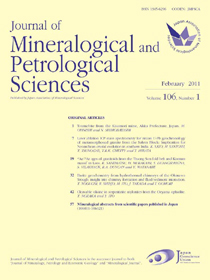巻号一覧

98 巻 (2003)
- 6 号 p. 207-
- 5 号 p. 167-
- 4 号 p. 137-
- 3 号 p. 93-
- 2 号 p. 47-
- 1 号 p. 1-
98 巻, 6 号
December
選択された号の論文の3件中1~3を表示しています
- |<
- <
- 1
- >
- >|
ORIGINAL ARTICLES
-
Shinji KOBAYASHI原稿種別: Others
専門分野: Others
2003 年 98 巻 6 号 p. 207-214
発行日: 2003年
公開日: 2004/04/22
ジャーナル フリーIn order to observe the relative diffusivity of Si4+, Al3+, Fe3+, Mg2+, Ca2+, Na+ and K+ between glass beads of JG-3 and SiO2, fusion of two glass beads was performed in an automated (high-frequency) inductive heating furnace. In addition to the above experiments, fusion of two glass beads of shoshonite and SiO2 was performed to observe the influence of compositions of glass on the form of convection cell. The observed order of diffusivity was Na+>K+>>Ca2+>Mg2+>Fe3+>Si4+, Al3+ under 1 atm, and 1200°C. The results are consistent with those reported by several earlier investigators under different conditions. The analytical method was applied in order to allow the observation of the change in shape of the convection cell. The present experiment illustrates the important roles of both convective stretching and chemical diffusion in the hybridization process of two liquids.抄録全体を表示PDF形式でダウンロード (5254K) -
Takahiro KURIBAYASHI, Yasuhiro KUDOH, Hiroyuki KAGI原稿種別: Others
専門分野: Others
2003 年 98 巻 6 号 p. 215-234
発行日: 2003年
公開日: 2004/04/22
ジャーナル フリーA single crystal high-pressure X-ray diffraction study of phase A was performed using a diamond anvil cell up to 11.2 GPa at ambient temperature. The chemical formula of this sample, determined by EPMA from an average of 18 data points, was Mg6.99Si1.99H6.06O14. Axial linear compressibilities of phase A were βa=2.92(2) and βc=2.17(3) (×10-3/GPa). The isothermal bulk modulus, calculated using the Birch-Murnaghan equation of state, was KT0=105(4) GPa with a pressure derivative K′=3.9(8) and V0=512.2(6) Å3. The bulk modulus correlates with the summation of the filling factor of the tetrahedral site and the octahedral site, as shown for the minerals on the forsterite-brucite join in the system MgO-SiO2-H2O.抄録全体を表示PDF形式でダウンロード (1235K) -
Samuel TETSOPGANG, Masaki ENAMI原稿種別: Others
専門分野: Others
2003 年 98 巻 6 号 p. 235-244
発行日: 2003年
公開日: 2004/04/22
ジャーナル フリーOrthoferrosilite (denoted as ferrosilite hereafter) with Fe# [=Fe2+/(Fe2++Mg)] up to 0.8, occurs in a quartz monzonite from the Nkambe area, Cameroon, a part of the Pan-African Mobile Belt. The ferrosilite-bearing monzonite is composed of ferro-edenite/ferrohornblende, plagioclase, K-feldspar, biotite, quartz, ilmenite and accessory allanite, zircon and apatite as matrix phases. Hedenbergite, as well as quartz, calcic amphibole and biotite are found as inclusions in plagioclase. Ferrosilite reacted to form grunerite, ferro-actinolite and minnesotaite during subsolidus cooling. Both plagioclase and K-feldspar show typical igneous-type zoning patterns with decreasing anorthite and albite components from the core towards rim, respectively. The core of K-feldspar usually shows micro-perthitic texture. The ferrosilite is possibly one of the most Fe-rich magmatic orthopyroxenes, yet reported in the literature, formed during equilibrium crystallization and indicates a minimum pressure of emplacement and solidification of the magma under a pressure of about 0.5 GPa. Combinations of equilibrium relations among calcic amphiboles, biotite, feldspars and quartz give pressure and temperature conditions of 0.6-0.7 GPa and 720-760°C. The breakdown of ferrosilite to grunerite suggests that during cooling the ferrosilite-bearing monzonite body cooled below 560°C under pressures in excess of 0.20-0.25 GPa, implying the existence of a relatively low P/T gradient of 0.2 GPa/100°C during decompression of the host rock.抄録全体を表示PDF形式でダウンロード (1463K)
- |<
- <
- 1
- >
- >|